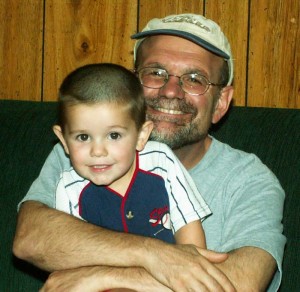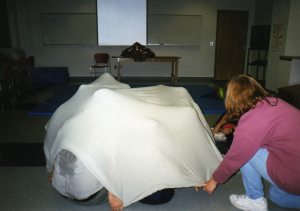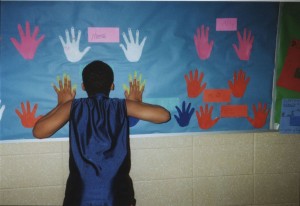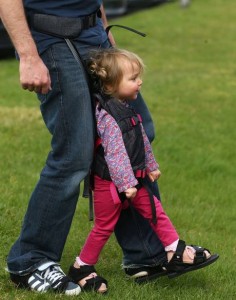 John Pagano[/caption]
John Pagano[/caption]
We would like to share this blog discussion from: John Pagano, a renowned member of Education Resources’ Faculty
John is teaching his popular conference: Effectively Treat Behavior in Children with Autism Spectrum and Other Sensory Challenges
May 2-3, 2014 – Las Vegas, NV
September 27-28, 2014 – Jacksonville, FL October 10-11, 2014 – Coon Rapids, MN
Please click above for full course details, to download a brochure or to register for the course.
Appropriate behavior for learning is enhanced by engaging sensory activities that teach rule based inhibitory movement control. Behavioral problems frequently involve inadequate inhibitory control of movement involving the arms (e.g., punching, slapping, scratching), legs (kicking) or mouth (e.g., spitting, biting, threatening, screaming, swearing). Teachers can collaborate with occupational, physical, speech/language, and mental health therapists to enhance self-control using developmentally appropriate movement activities with children and adolescents who have behavioral, mental health, sensory processing, and/or developmental challenges.
A major obstacle in teaching youngsters with behavioral challenges is motivating them to participate in challenging activities to enhance their development. Children and adolescents find movement activities engaging and fun. Involving students in brief developmentally appropriate movement brake activities enhances academic transitions, self-control and learning. Helpful activities include: playground tasks, parachute games, Simon says, red light, giant steps freeze dance, freeze shake, play plan, play review, obstacle courses, and movement to music (10 little hotdogs, Hokey-pokey, If your happy and you know it, Hot cross buns, We all need somebody to lean on).
 Additionally, basic yoga and mindfulness activities provide sensory movement that is useful as a pre-correction technique (e.g., activity used before problematic situations like school assemblies or lunch time). Pre-school and elementary classes benefit from mindfulness and basic yoga tasks such as the: wall pressing, tensing then relaxing their muscles, mindful clock, body scan, feel your feet, feel your palms, stretching activities, and isometric exercises.
Children with behavioral and sensory processing problems often show improved behavior following movement activities involving slow linear movement and deep pressure (e.g., pushups, wall pushups, desk pressing, rocking onto their hands on their stomachs over a therapy ball). Helpful activities for students with behavioral and sensory processing challenges who are integrated into a regular education program include: setting the table, moving mats, moving tables, moving chairs, passing out books, and delivering notes or packages to teachers through out the school.
Additionally, basic yoga and mindfulness activities provide sensory movement that is useful as a pre-correction technique (e.g., activity used before problematic situations like school assemblies or lunch time). Pre-school and elementary classes benefit from mindfulness and basic yoga tasks such as the: wall pressing, tensing then relaxing their muscles, mindful clock, body scan, feel your feet, feel your palms, stretching activities, and isometric exercises.
Children with behavioral and sensory processing problems often show improved behavior following movement activities involving slow linear movement and deep pressure (e.g., pushups, wall pushups, desk pressing, rocking onto their hands on their stomachs over a therapy ball). Helpful activities for students with behavioral and sensory processing challenges who are integrated into a regular education program include: setting the table, moving mats, moving tables, moving chairs, passing out books, and delivering notes or packages to teachers through out the school.
Finally, special accommodations can sometimes be made for children who are  academically bright but have difficulty maintaining a sustained seated position. Sitting on therapy balls, sitting on disk-o-sit cushions, standing in a masking taped area, or using a sensory area in the back of the class where they can do there work without disturbing or being disturbed by others. Rolling to read and rolling to math are useful activities for children who can’t remain seated but are capable of academically advanced work. During resource room, occupational and speech/language therapy, and home work sessions they roll across the floor then read a chapter in a book or complete several math flash cards. After completing the reading or math they are reinforced then roll again and do the next chapter or flash cards.
Particularly for preschool, kindergarten, and all students who have behavioral, psychiatric, developmental, sensory processing, and/or trauma history challenges it helps to include movement activities in the classroom. Students are initially taught the cardinal rules for movement tasks: “Don’t touch any body or anything with out permission, and resume good learning after so we can do this activity tomorrow (if not we will skip this activity tomorrow then try it again the next day and I’m sure you will do much better”). Teachers and principles understand that students benefit from movement engaging the bodily-kinesthetic, interpersonal, and musical intelligences. While the teachers I work with and I am accused of “coddling students” and “wasting time” by using movement activities in the class room, no one can dispute our data showing this method results in increased academic goal achievement and decreased behavioral problems.
References:
Dunn, W. (2007). Supporting children to participate successfully in everyday life by using sensory processing knowledge. Infants & Young Children, 20(2), 84-101.
Flook, L., Smalley, S., Kitil, M., Galla, B., Kaiser-Greenland, S., Locke, J., Ishijima, E., Kasari, C. (2010). Effects of mindful awareness practices on executive functions in elementary school children. Journal of Applied School Psychology, 26, 70-95.
Koester, C. (2012). Movement based learning for children of all abilities. Reno, NV: Movement Based Learning Inc.
Riggs, N.R., Greenberg, M.T., Kusche, C.A., Pentz, M.A. (2006). The mediational role of neurocognition in the behavioral outcomes of a social-emotional prevention program in elementary school students: Effects of the PATHS curriculum. Prevention Science, 7(1), 91-102.
Warner, E., Koomar, J., Lary, B . & Cook, A. (2013). Can the body change the score? Application of sensory modulation principles in the treatment of traumatized adolescents in residential treatment settings. Journal of Family Violence, 28(7), 729-738.
academically bright but have difficulty maintaining a sustained seated position. Sitting on therapy balls, sitting on disk-o-sit cushions, standing in a masking taped area, or using a sensory area in the back of the class where they can do there work without disturbing or being disturbed by others. Rolling to read and rolling to math are useful activities for children who can’t remain seated but are capable of academically advanced work. During resource room, occupational and speech/language therapy, and home work sessions they roll across the floor then read a chapter in a book or complete several math flash cards. After completing the reading or math they are reinforced then roll again and do the next chapter or flash cards.
Particularly for preschool, kindergarten, and all students who have behavioral, psychiatric, developmental, sensory processing, and/or trauma history challenges it helps to include movement activities in the classroom. Students are initially taught the cardinal rules for movement tasks: “Don’t touch any body or anything with out permission, and resume good learning after so we can do this activity tomorrow (if not we will skip this activity tomorrow then try it again the next day and I’m sure you will do much better”). Teachers and principles understand that students benefit from movement engaging the bodily-kinesthetic, interpersonal, and musical intelligences. While the teachers I work with and I am accused of “coddling students” and “wasting time” by using movement activities in the class room, no one can dispute our data showing this method results in increased academic goal achievement and decreased behavioral problems.
References:
Dunn, W. (2007). Supporting children to participate successfully in everyday life by using sensory processing knowledge. Infants & Young Children, 20(2), 84-101.
Flook, L., Smalley, S., Kitil, M., Galla, B., Kaiser-Greenland, S., Locke, J., Ishijima, E., Kasari, C. (2010). Effects of mindful awareness practices on executive functions in elementary school children. Journal of Applied School Psychology, 26, 70-95.
Koester, C. (2012). Movement based learning for children of all abilities. Reno, NV: Movement Based Learning Inc.
Riggs, N.R., Greenberg, M.T., Kusche, C.A., Pentz, M.A. (2006). The mediational role of neurocognition in the behavioral outcomes of a social-emotional prevention program in elementary school students: Effects of the PATHS curriculum. Prevention Science, 7(1), 91-102.
Warner, E., Koomar, J., Lary, B . & Cook, A. (2013). Can the body change the score? Application of sensory modulation principles in the treatment of traumatized adolescents in residential treatment settings. Journal of Family Violence, 28(7), 729-738.
]]>
 [/caption]
[/caption]

 [/caption]
[/caption]
 John Pagano[/caption]
John Pagano[/caption]

